|
Have a safe day!
Thursday, Jan. 12
12 p.m.
Computing Sector Brown Bag Seminar - One West
Speaker: Phil Panopio, Fermilab
Title: Tutorial on Outlook Basics
2:30 p.m.
Theoretical Physics Seminar - WH2NW
Speaker: Alexander Knochel, University of Heidelberg
Title: Superluminal Neutrinos
3:30 p.m.
DIRECTOR'S COFFEE BREAK - 2nd Flr X-Over
THERE WILL BE NO ACCELERATOR PHYSICS AND TECHNOLOGY
SEMINAR TODAY
Friday, Jan. 13
3:30 p.m.
DIRECTOR'S COFFEE BREAK - 2nd Flr X-Over
4 p.m.
Joint Experimental-Theoretical Physics Seminar - One West
Speaker: Rouven Essig, University of New York, Stony Brook
Title: The Search for Dark Photons and the g-2 Anomaly
Click here for NALCAL,
a weekly calendar with links to additional information.
Upcoming conferences |
|
Thursday, Jan. 12
- Breakfast: Apple sticks
- Tomato florentine
- BBQ pork sandwich
- Smart cuisine: Kielbasa & sauerkraut
- Smart cuisine: Chicken marsala
- Smoked turkey melt
- Assorted sliced pizza
- Southwestern chicken salad w/ roasted corn salsa
Wilson Hall Cafe Menu
|
|
Friday, Jan. 13
Dinner
- Coquille St. Jacques
- Pork tenderloin w/ marsala sauce
- Steamed broccoli
- Roasted potatoes w/ onions
- Apple turnover w/ cream chantilly
Wednesday, Jan. 18
Lunch
- Chicken satay
- Jasmine rice
- Snow peas
- Coconut cake
Chez Leon Menu
Call x3524 to make your reservation. |
|
Video: Assembly of prototype blocks for NOvA detector
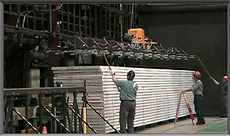 |
|
This time-lapse video shows custom-made gluing and lifting machines to assemble prototype detector blocks for the NOvA experiment.
|
In March, the NOvA collaboration will start the assembly of its 15,000-ton neutrino detector in Ash River, Minnesota. When complete, the NOvA detector will be one of the largest plastic structures ever to be built. It will comprise 368,640 tubes of white PVC that will support the entire weight of the detector. This time-lapse video shows the assembly of prototype detector blocks at Argonne National Laboratory using custom-made lifting and gluing machines. Scientists tested another critical piece of equipment for the assembly of the detector, the NOvA pivoter, at Fermilab in November; see this second video.
The NOvA collaboration will also build a smaller 222-ton neutrino detector at Fermilab, inside a cavern to be excavated next to the MINOS hall, 330 feet underground. When operational, the two detectors will examine the world's highest-intensity, longest-distance neutrino beam, sent from Fermilab to Ash River—500 miles straight through the earth. By comparing the composition of the neutrino beam in Ash River with the original one at Fermilab, the NOvA collaboration expects to discover how the masses of the three known types of neutrinos stack up. Scientists from 28 institutions are working on the NOvA experiment.
—Kurt Riesselmann
|
A sunset in the new year
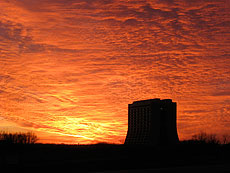 |
|
On Friday, Jan. 6, an orange sun lit the sky before darkness settled in for the night. Photo: Michael Tartaglia, TD
|
|
Belle experiment makes exotic discovery
The Belle Experiment at KEK laboratory in Japan has discovered two unexpected new types of hadrons. Hadrons are composite particles made up of quarks, the smallest known components of matter.
These new particles are thought to contain at least four quarks, making them exotic hadrons — hadrons that do not fit the quark model originally developed in 1961.
The B Factory experiment at KEK previously discovered exotic hadrons containing charm quarks. With this new finding, the Belle experiment has identified the first of this type of exotic hadrons discovered to contain bottom quarks, the second-heaviest type of quarks among the six known types of quarks. The particles, termed Zb, contain both one bottom quark and one anti-bottom quark.
Read more
—Kathryn Grim
|
Three new maps shine light on dark matter
From PhysicsWorld.com, Jan. 11, 2012
Three independent teams of astronomers have released new and improved maps of where dark matter is lurking in parts of the universe. All three groups have charted the mysterious substance by looking at how its presence distorts the images of distant galaxies as their light travels to Earth. As well as providing further insights into dark matter, the studies could provide crucial information about another mysterious substance – dark energy.
About 95% of the mass/energy content of the universe is believed to comprise dark matter and dark energy – two substances about which physicists know very little. Dark matter cannot be observed directly but is believed to make up about 23% of the mass/energy in the universe. Its existence has been inferred from the gravitational tug that it exerts on visible matter such as galaxies. Dark energy, which is also invisible, is thought to account for about 72 percent of the mass/energy and its existence is inferred from the accelerating expansion of the universe.
Read more
|
Japan's Super-K to resume seeking why anything exists
From The Japan Times, Jan. 8, 2012
To start the year, here's an appreciation of a site in Japan that would have left even the Zen-imbued architects of Kyoto's sublime Kinkaku-ji (Temple of the Golden Pavilion) open-mouthed with awe.
Not only that, but it's a site where basic questions about the nature of reality are being probed — questions that go beyond even the most mind-bending conundrums posed by Zen masters at the Enkaku-ji Temple in Kamakura, Kanagawa Prefecture. (And I know they are mind-bending because I went on a Zen course there once, and we had to wake at 4 a.m. every day to meditate upon them.)
The site I speak of is the Super-Kamiokande detector located under Mount Kamioka in the Japanese Alps near Hida City, Gifu Prefecture.
There is certainly no shortage of UNESCO World Heritage Sites in Japan, but to my mind the detector of the Super-Kamiokande — the Super-Kamioka Nucleon Decay Experiment to give it its full name, though it's normally abbreviated to Super-K — deserves at least as much attention. I only wish it was as easy to visit as those on the World Heritage tourist trail.
However, this Super-K story starts not in Gifu but some 120 km north of Tokyo in a village called Tokai on the Pacific coast of Ibaraki Prefecture. Until now, Tokai has perhaps been best known as the site of a nuclear accident in 1999 which killed two people — but this may soon change.
Read more
|
|
Do extra dimensions hide under our toes?
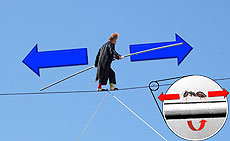 |
|
A man on a high wire can only move in one dimension, but an ant on the same wire can move either along or around the wire. Does such a compact extra dimension exist as a fourth dimension of space?
|
A man on a high wire can only choose to move along the wire towards either end. For all his acrobatic prowess, he could not imagine moving along the wire in more than that single dimension. On a smaller scale, perhaps from the point of view of an ant sharing the wire with an acrobat, the second dimension of movement around the wire becomes apparent. Though this extra dimension is compact, or both finite and looped back upon itself, the surface of the wire is certainly two dimensional and noticing that extra dimension is simply a question of the scale of your probe.
The universe appears to have three spatial dimensions, but compact extra spatial dimensions might exist. It's possible that we simply haven't noticed them yet due to the limitations of our probes. The smaller a compact dimension is, the higher the energy of the probe must be in order to notice that dimension. Using the Tevatron as a probe, physicists at DZero have recently completed a search for a universal extra dimension that all particles could propagate through. Motion in this finite extra dimension would allow a set of resonant modes, or new excited states, for every particle produced in a proton-antiproton collision. The lightest excitation among all particles would be stable and a candidate for describing the dark matter in the universe.
Each time an excited quark state is created it will undergo a cascading decay that could produce many charged leptons. By focusing their analysis on events with two muons that have the same charge sign, the DZero team was able to perform the search in a channel that has a low background. The team further enhanced their sensitivity to a universal extra dimension by creating a signal discriminant using multivariate analysis techniques. Seeing no evidence for new physics in the DZero data, the analysis team set direct limits on the size of a universal extra dimension.
—Mike Cooke
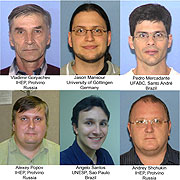 |
|
These physicists made major contributions to this analysis.
|
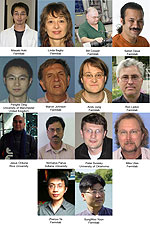 |
|
This team monitored, maintained and serviced the Silicon Microstrip Tracker, the innermost and highest resolution subdetector of the DZero experiment critical for many DZero studies, including the analysis described above.
|
|
|